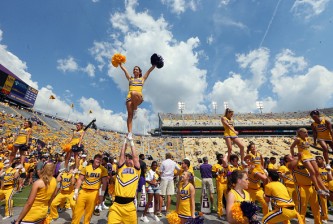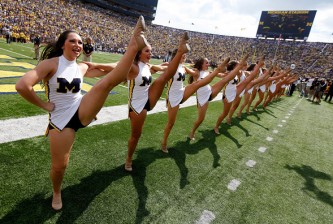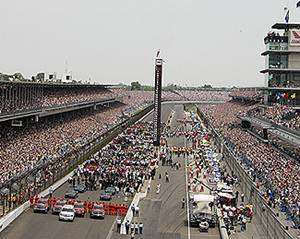ESPN/ABC gives us some background on its coverage of this year’s Indianapolis 500 and also some history of ABC’s broadcasts dating back 45 years. I’m kind of surprised ESPN actually embraced ABC’s history with the race.
Indianapolis 500 Airing on ABC for 45th Consecutive Year
ESPN’s Production of Sunday’s Live Coverage Continues a TV Tradition Dating to 1965
When the Indianapolis 500 aired on ABC for the first time, Lyndon Johnson was in the White House, the NFL Championship was almost two years away from becoming the Super Bowl, the Beatles and Beach Boys were at the top of the charts and Bewitched and Bonanza ruled the TV airwaves.
One of the longest-running relationships between a sporting event and a network continues on Sunday, May 24, when the Indianapolis 500 airs on ABC for the 45th consecutive year. ESPN on ABC’s live, high definition telecast from Indianapolis Motor Speedway begins at noon ET, with the green flag at 1 p.m.
Television coverage of the “Greatest Spectacle in Racing” has come a long way since highlights first appeared in black-and-white on ABC’s Wide World of Sports program following the 1965 edition of the race.
ESPN will use 59 cameras to televise the race fully in high definition, including a 360-degree rotating onboard camera mounted behind the driver on multiple cars. Unique views will be provided by Track Cam, a high definition camera running on a cable over pit road and the frontstretch that can move at more than 80 mph. All 33 cars will carry GPS boxes for the Sportvision RaceFX system to provide telemetry and pointers to help identify the cars for viewers. And ESPN will use a radio replay system that can record, play back and edit radios from any of the 33 drivers.
The one-hour pre-race show will include interviews with many of the starting drivers as well as four special features, including a look at the roller-coaster year of polesitter Helio Castroneves; the special relationship between Danica Patrick and her father; the “Super Team” of Scott Dixon and Dario Franchitti; and the Allure of Indy – why drivers will risk everything just to be able to compete in the Indy 500
ESPN’s veteran team returns for the Indianapolis 500 telecast
. Marty Reid will call the race, with analysis by former IndyCar Series star Scott Goodyear and 1998 Indy 500 winner Eddie Cheever. Reporting from the pits will be Jack Arute, Jamie Little, Brienne Pedigo and Vince Welch while Brent Musburger hosts the telecast. Arute has covered the event for ABC every year since 1984.Some of the most familiar names in sports television history have been a part of ABC’s Indianapolis 500 coverage over the years, including Jim McKay, Keith Jackson, Chris Schenkel, Bill Flemming, Al Michaels, Paul Page and current host Musburger.
Early in his television career, Indiana native David Letterman worked as a pit reporter for ABC in 1971, and years later the late night talk show host would win the race as a car owner in 2004 with driver Buddy Rice.
Chris Economaki was a pit reporter and analyst on ABC’s Indy 500 coverage for years, while Jackie Stewart, Bobby Unser, Sam Posey, Rodger Ward and Rusty Wallace are among those who served as driver-analysts.
Charlie Brockman, a television personality in Indianapolis at the time, was the commentator on ABC’s first coverage of the race in 1965. Brockman had previously been the lap-by-lap announcer for closed-circuit telecasts of the race that were the norm before ABC’s coverage began. The race remained part of Wide World of Sports until 1971, when it aired for the first time as a same-day, stand-alone, tape-delayed telecast in prime time.
Because Indianapolis Motor Speedway did not want the event to air live at the time, it was shown on a delayed basis until 1986. The race telecast is still blacked out in the Indianapolis area, airing later that night.
“The stewardship of ABC’s storied history at the Indianapolis 500 is something we take very seriously,” said Jed Drake, ESPN senior vice president and executive producer. “The heritage of this event, and the pure excitement and spectacle of it, are what we look forward to bringing to our viewers every year.”
Other ESPN Platforms
In addition to the live telecast on ABC, the Indianapolis 500 will receive multiplatform coverage on other ESPN outlets:
ESPN International’s networks and syndication of Indy 500 will reach 213 countries and territories and more than 292 million households. In addition, U.S. troops serving overseas and on Navy vessels around the world will watch via a broadcast agreement between ESPN and the American Forces Network.
ESPN.com will provide surround coverage of the Indy 500 with senior motorsports writer Terry Blount leading a team that includes IndyCar correspondent John Oreovicz and motorsports correspondent John Schwarb at the venerable speedway. In addition, anchor Marty Reid and analysts Scott Goodyear and Eddie Cheever will provide exclusive digital coverage of the “The Greatest Spectacle in Racing,” led by Cheever’s frequent ESPN.com contribution, “Leave It To Cheever.”
On television, extensive reports, interviews and highlights will air on SportsCenter and ESPNEWS.
ESPN Classic will re-live some great classic Indianapolis 500 races of the past in a marathon on Saturday, May 23, beginning at 1 p.m. ET. The marathon, presented by GoDaddy.com, features racing legends and former Indy 500 winners Al Unser Sr. and Jr. and Dario Franchitti. Franchitti, the 2007 winner, will provide exclusive commentary about his experiences during that race for ESPN Classic. The Indy 500 Marathon begins with SportsCentury: Al Unser Sr., followed by the 1987, 1992, 2005, 2007 and 2008 races.
ESPN Radio’s Saturday RaceDay starts its engines at 6 a.m. ET with an hour of news, previews and analysis. ESPN Radio also provides auto racing fans the comprehensive Sunday RaceDay (6-7 a.m. Sundays), which covers the auto racing world.
ESPN Deportes, ESPN’s Spanish-language television, radio and Internet in the U.S., will cover the Indy 500 via SportsCenter and RPM Semanal, the network’s first news and information program completely aired online on ESPNdeportes.com. Former professional driver Alex Pombo will be in Times Square to cover the 33-driver starting field’s New York visit on Tuesday of race week. His report will focus on interviews with the Hispanic drivers, including Ernesto Viso, Helio Castroneves and Milka Duno. RPM Semanal will be available on ESPNdeportes.com starting Wednesday, May 20, at 1 p.m. ET. The show will offer post analysis of Indy 500 during its Wednesday, May 27 edition.
Visit www.espnmediazone.com for ESPN’s latest releases, schedules and other news, plus photos, video and audio clips and more.
Indianapolis 500 Historical Notes
The telecast of the 2009 Indianapolis 500 by ESPN on ABC marks the 45th consecutive year that the “Greatest Spectacle in Racing” has been televised on ABC, one of the longest-running relationships ever between a sporting event and a TV network. Some important dates and milestones regarding the Indianapolis 500 on ABC:
1965 – The relationship between ABC and the Indianapolis 500 begins when highlights of the race are shown on the Wide World of Sports program. Charlie Brockman is the lap-by-lap announcer.
1966 – Chris Schenkel handles the lead announcer duties.
1967 – Jim McKay works the Indy 500 telecast for the first time as lap-by-lap announcer, with former race winner Rodger Ward in the new role of driver analyst on ABC’s coverage. Ward also works the 1968 and 1969 races for ABC. The race is shown in color for the first time after two years in black-and-white.
1971 – For the first time, ABC’s coverage of the Indianapolis 500 airs as a same-day, stand-alone, tape-delayed telecast in prime time rather than as part of the Wide World of Sports program. Chris Schenkel is host, with Jim McKay calling the action. Jackie Stewart makes his debut as driver analyst. Pit reporters include Chris Economaki, Bill Flemming, Keith Jackson and future Indy 500 winning team owner and late night talk show host David Letterman. The infamous crash of the pace car, in which Schenkel, astronaut John Glenn and speedway owner Tony Hulman were riding, into a photographer’s stand on the race start occurred this year.
1975 – Keith Jackson handles anchor duties for ABC as Jim McKay misses the race for the only time between 1967 and his final race in 1987.
1981 – Jackie Stewart works his final Indianapolis 500 as driver analyst. Sam Posey replaces him the following year.
1983 – Al Unser and Rick Mears carry onboard cameras, the first used in Indy 500 coverage.
1984 – Jack Arute works his first Indianapolis 500 for ABC as a pit reporter, a role that continues in 2009.
1986 – After many years of airing tape-delayed because Indianapolis Motor Speedway did not want a live telecast, the race is televised live for the first time. The ra
ce was still blacked out locally, a practice that continues to this day. Ironically, the race was rained out on both Sunday and Monday, so it was run the following Saturday and televised live on ABC. Jim Lampley makes his debut as lead announcer with Jim McKay in the host position.
1987 – Jim McKay, who serves as host, works his final Indianapolis 500 for ABC. Jim Lampley is lap-by-lap announcer, with driver analysts Bobby Unser and Sam Posey.
1988 – Paul Page becomes anchor for ABC’s coverage after serving as lead announcer on the IMS Radio Network for 10 years. Page is lead announcer from 1988-1998, then returns from 2002-2004.
1989 – Dr. Jerry Punch starts a 18-year run as a pit reporter on ABC’s Indianapolis 500 coverage.
1999 – Bob Jenkins is lead announcer for the first of three years, with Al Michaels as host of the telecast. Jenkins becomes host in 2002 when Paul Page returns to lead announcer slot.
2001 — Vince Welch works his first Indianapolis 500 as an ABC pit reporter. He had worked as a turn announcer and pit reporter for the IMS Radio Network since 1996.
2002 – Scott Goodyear makes his debut as driver analyst after retiring from driving following the 2001 Indy 500.
2004 — Several rain delays take the telecast to 8 l/2 hours, making for one of the longest single-event telecasts ever. A 180-degree rotating onboard camera was added to ABC’s coverage.
2005 – Brent Musburger becomes host of the telecast as Todd Harris fills the lead announcer role for one year. Jamie Little works her first Indianapolis 500 as a pit reporter.
2006 – Marty Reid makes his debut as lead announcer for the Indianapolis 500 with former NASCAR champion Rusty Wallace joining Scott Goodyear as driver analyst. ABC introduces the “side-by-side” format, allowing viewers to continue watching the action during national commercial breaks.
2007 – The race is televised in high definition for the first time. ESPN on ABC is the first network to use t
wo women as pit reporters in coverage of the Indianapolis 500 as Brienne Pedigo joins Jamie Little in the pits.
2008 – Eddie Cheever Jr., the 1998 winner, makes his debut as driver analyst, joining Scott Goodyear. Coverage includes a 360-degree rotating onboard camera, the first of its kind in American motorsports.
To be honest, I haven’t watched an Indianapolis 500 for many years, but it’s always interesting to read about ABC’s history with the race.

























